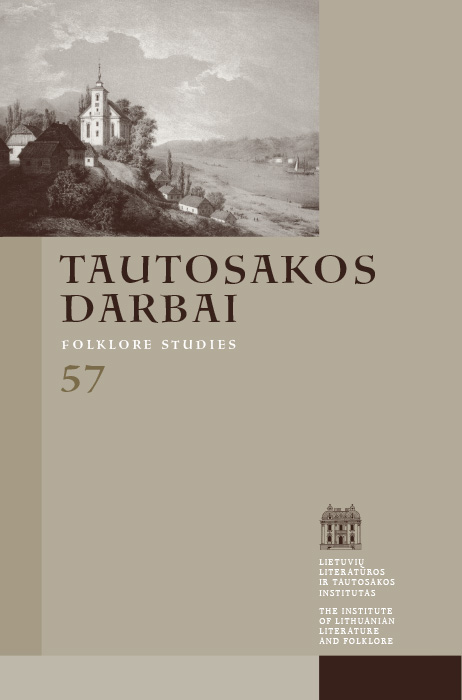The Great Songbooks: Origins of the Academic Lithuanian Folksong Edition in Folklore Publications by Brothers Juška
Abstract
The aim of the article is revealing the origins of the academic edition of the Lithuanian folksongs. The subject of analysis comprises the folklore heritage of the most famous collector of the traditional Lithuanian culture from the 19th century, including folksongs, wedding customs, and lexical data – priest Antanas Juška (1819–1880). He recorded over 7000 of Lithuanian folksongs, including 1852 melodies. Juška accumulated the majority of these songs during a comparatively short period of time, i. e. approximately in 1864–1871, and in a rather small locality of Lithuania – namely, the Veliuona parish, from about 150 performers. When editing folklore manuscripts for publication, Antanas Juška received help from his brother, linguist and pedagogue Jonas Juška, who lived and worked not in Lithuania, but in various places across the Russian empire, staying in Kazan for a longer period of time with his family. In 1880–1883, two folksong books edited by brothers Juška were published in Kazan and St Petersburg: Lietuviškos dainos (‘Lithuanian Songs’, 3 volumes comprising 1569 songs), and Lietuviškos svotbinės dainos (‘Lithuanian Wedding Songs’, 1100 songs). A detailed description of the 19th century Lithuanian wedding customs recorded by Antanas Juška in Veliuona also saw publication. It is noteworthy, however, that these publications took place during the period of banning the Lithuanian press in Latin alphabet that the tsarist Russian regime introduced following the uprising of the 1863. The possibility to publish the folksong books by brothers Juška in Lithuanian was the result of an active campaign by professor of the Kazan University Baudouin de Courtenay and other members of the Russian Academy of Science, who supported Lithuanians and the Lithuanian culture.
Antanas Juška collected folklore in a rather different way from his earlier colleagues – collectors and publishers of the Lithuanian folklore. He was the first in the history of the Lithuanian folklore to provide detailed data on his informants, as well as indicating places of recording and presenting multiple variants of the recorded folksongs. Besides, he sought collecting not only the most ancient and poetic folksongs (as was customary in the 19th century and later), but attempted recording all the traditional lore of the time, refusing to differentiate between the old and the new, valuable and worthless, beautiful and plain songs. The author of the article focuses on his personality, attempting to establish the features of his character that determined such intense ethnographic activity. According to his contemporaries, Antanas Juška was a lively person and a popular priest, maintaining close connections with his folklore performers.
Exactly 100 years after the publication of the first part of Antanas Juška folksong book, the academic multivolume publication of the Lithuanian folksongs was launched in 1980 in Vilnius. The origins of the principles of academic edition adopted for this publication (e. g. introducing the folksong variation, dialectological editing, detailed registering of the performers’ data, etc.) can be easily recognized in the folklore publications by Juška. Besides, all the hitherto published 24 volumes of various folksong genres include songs recorded and published by Juška. Folklore materials that he recorded also come useful for the scholarly commentaries to the songs.
The article also discusses the appreciation of the folksong books by brothers Juška – both at the time of their publication in the second half of the 19th century and later.
Downloads
Most read articles by the same author(s)
- Austė Nakienė, Radvilė Racėnaitė, Vita Ivanauskaitė-Šeibutienė, Rytis Ambrazevičius, Lina Būgienė, Gražina Kadžytė, Rima Visackienė, Irena Žilienė, Andželika Jakubynienė, Chronicle , Tautosakos darbai: Vol. 52 (2016)
- Vita Ivanauskaitė-Šeibutienė, The Resonant Table: Drinking-Songs in the Traditional Community Gatherings , Tautosakos darbai: Vol. 50 (2015)
- Vita Ivanauskaitė-Šeibutienė, Reflection of Tradition in Artist’s Writings, or Learning Anthropology from Stasys Eidrigevičius , Tautosakos darbai: Vol. 55 (2018)
- Vita Ivanauskaitė-Šeibutienė, LITUANUS: The Lithuanian Quarterly Journal of Arts and Sciences, vol. 60:4, Winter 2014 , Tautosakos darbai: Vol. 49 (2015)
- Vita Ivanauskaitė-Šeibutienė, Folkloric Language of the Dream: Oneiric Narratives in the Social Communication , Tautosakos darbai: Vol. 48 (2014)
- Lina Būgienė, Vita Ivanauskaitė-Šeibutienė, Akvilė Sadauskienė, Information , Tautosakos darbai: Vol. 63 (2022)
- Vita Ivanauskaitė-Šeibutienė, Folkloristics without Illusions. Some Thoughts on the Contexts of Folklore Research by Donatas Sauka , Tautosakos darbai: Vol. 58 (2019)
- Audronė Gedžiūtė, Jūratė Šlekonytė, Jurgita Ūsaitytė, Vita Ivanauskaitė-Šeibutienė, Chronicle , Tautosakos darbai: Vol. 57 (2019)
- Vita Ivanauskaitė-Šeibutienė, The Dreamed up Community: Connections of the Family Members in the Traditional Dream Narratives , Tautosakos darbai: Vol. 51 (2016)
- Vida Norvaišienė, Dainius Razauskas, Rūta Žarskienė, Vita Ivanauskaitė-Šeibutienė, Lina Būgienė, Chronicle , Tautosakos darbai: Vol. 49 (2015)




